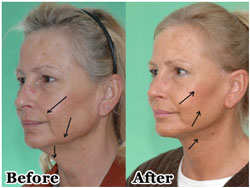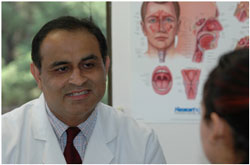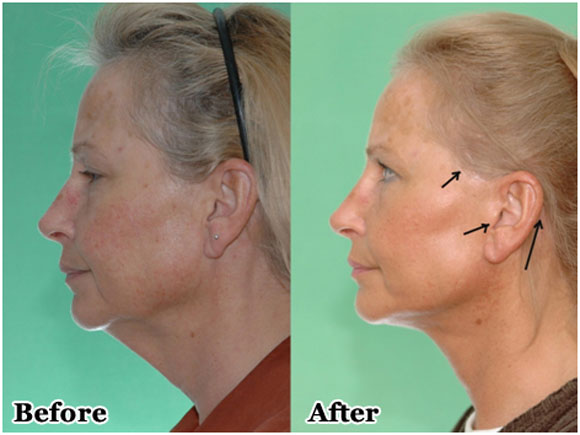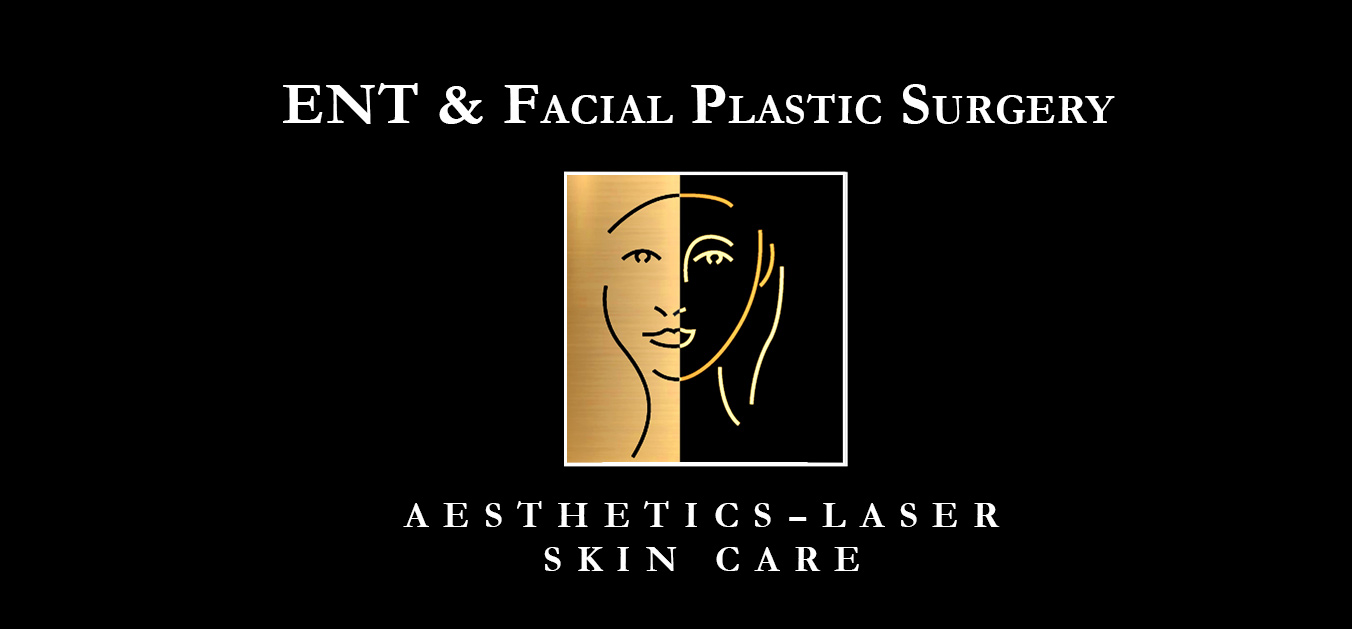Facelift (also known as necklift or rhytidectomy)
Question: Do I need a facelift?
 Answer: Facelift or rhytidectomy is an appropriate procedure for those who want to change the appearance of their neck and/or midface. The main question to ask oneself is specifically which aspects of your neck and face you would like to change. Although the procedure will eliminate most wrinkles however the main purpose of the procedure is to reposition the skin and the underlying soft tissues back to an earlier stage in life. As the face ages, the malar fat pad descends downwards and towards the middle of the face resulting in prominent deep lines around the mouth and development of jowls. In the neck region, the platysma muscle has a natural opening in the middle which allows for the fat from the floor of mouth area to herniate and the muscles lose their attachments in the neck, the overlying skin becomes lax; these changes result in the excessive loose tissue in the midline of the neck also known as the “turkey” neck appearance (see patient figure). The facelift procedure has undergone significant evolution over the past few decades. The procedure can range from a short flap technique where the skin is elevated and retracted and re-sutured to a composite or deep plane lift where all layers of soft tissue are elevated and repositioned. The procedure may include a head and neck liposuction procedure and extensive repositioning of the neck soft tissues. It is important to remember that changing the face by very small increments can result in dramatic changes in the appearance. A desirable result is one which allows the patient’s natural beauty to be enhanced while correcting any asymmetries or irregularities. Obtaining ideas from pictures of models in magazines can help you decide what is aesthetically pleasing to you; however, it is usually unrealistic to attempt to look like someone else. The job of a good surgeon is to understand your goals and to advise you, based on his assessment and experience, on the best facelift procedure.
Answer: Facelift or rhytidectomy is an appropriate procedure for those who want to change the appearance of their neck and/or midface. The main question to ask oneself is specifically which aspects of your neck and face you would like to change. Although the procedure will eliminate most wrinkles however the main purpose of the procedure is to reposition the skin and the underlying soft tissues back to an earlier stage in life. As the face ages, the malar fat pad descends downwards and towards the middle of the face resulting in prominent deep lines around the mouth and development of jowls. In the neck region, the platysma muscle has a natural opening in the middle which allows for the fat from the floor of mouth area to herniate and the muscles lose their attachments in the neck, the overlying skin becomes lax; these changes result in the excessive loose tissue in the midline of the neck also known as the “turkey” neck appearance (see patient figure). The facelift procedure has undergone significant evolution over the past few decades. The procedure can range from a short flap technique where the skin is elevated and retracted and re-sutured to a composite or deep plane lift where all layers of soft tissue are elevated and repositioned. The procedure may include a head and neck liposuction procedure and extensive repositioning of the neck soft tissues. It is important to remember that changing the face by very small increments can result in dramatic changes in the appearance. A desirable result is one which allows the patient’s natural beauty to be enhanced while correcting any asymmetries or irregularities. Obtaining ideas from pictures of models in magazines can help you decide what is aesthetically pleasing to you; however, it is usually unrealistic to attempt to look like someone else. The job of a good surgeon is to understand your goals and to advise you, based on his assessment and experience, on the best facelift procedure.
Question: How do I decide on a surgeon?
 Answer: This is one of the most, if not the most, important step in the process of achieving your aesthetic goals. After performing many revision surgeries on patients, I assure you it is better to put the time and effort into carefully selecting a capable facial plastic surgeon to perform surgery the first time than to suffer a poor outcome and then have to look for a capable surgeon to fix it. Revision surgery is very difficult and few facial plastic surgeons perform these procedures; therefore, the process becomes even more daunting for the patient the second time around. Carefully review the surgeon’s training and certification. Board certification by the American Board of Otolaryngology and American Board of Facial Plastic and Reconstructive Surgery shows that the surgeon has comprehensive training in performing an aesthetic facelift procedure. Determine the length of time a surgeon has been in practice and the breadth of the practice, as nothing can substitute for the wisdom and skill a surgeon derives from having performed many procedures.
Answer: This is one of the most, if not the most, important step in the process of achieving your aesthetic goals. After performing many revision surgeries on patients, I assure you it is better to put the time and effort into carefully selecting a capable facial plastic surgeon to perform surgery the first time than to suffer a poor outcome and then have to look for a capable surgeon to fix it. Revision surgery is very difficult and few facial plastic surgeons perform these procedures; therefore, the process becomes even more daunting for the patient the second time around. Carefully review the surgeon’s training and certification. Board certification by the American Board of Otolaryngology and American Board of Facial Plastic and Reconstructive Surgery shows that the surgeon has comprehensive training in performing an aesthetic facelift procedure. Determine the length of time a surgeon has been in practice and the breadth of the practice, as nothing can substitute for the wisdom and skill a surgeon derives from having performed many procedures.
I am double boarded in Otolaryngology and Facial Plastic and Reconstructive surgery. My training and 20 years of experience has allowed me to approach facial aesthetic surgery from both perspectives; hence, I am able to perform the procedure safely and fulfill my patients’ goals. I perform both primary and revision facelifts on diverse age groups, gender, and ethnicities. I feel my surgical experience allows me to perform a surgery which addresses each individual’s needs without compromising his or her natural beauty. Most of my new patients are referrals from previous patients. Please refer to my profile page for details of my credentials.
Question: How can I discuss my thoughts with my surgeon?
 Answer: You can schedule a facial consultation. After discussing your goals, I will examine your nose thoroughly. You will undergo computer imaging and analysis which will allow us to discuss the changes you desire in detail. It is very important to understand precisely what your surgeon is planning for you and the computer imager will allow you to visualize both yours and your surgeon’s thoughts. Schedule a Facial Consultation
Answer: You can schedule a facial consultation. After discussing your goals, I will examine your nose thoroughly. You will undergo computer imaging and analysis which will allow us to discuss the changes you desire in detail. It is very important to understand precisely what your surgeon is planning for you and the computer imager will allow you to visualize both yours and your surgeon’s thoughts. Schedule a Facial Consultation
Question: Can I see some before and after pictures?
Answer: Yes. I have included some of my photos on this website for your perusal along with patient testimonials. I have 20 years of digital images. I started using the video imaging technology during its early beginnings; therefore, I have many patient photos to share with you. Photos of patients are released by patient consent only. A patient’s right to privacy is strictly observed. View our Photo Gallery.
Questions: Do you have any patient  testimonials?
testimonials?
Answer: Yes. Below is a sample of how my patients feel or click here to read all the patient testimonials.
Krista – Oct 7, 2011 – “I have had some really bad experiences with doctors over the years, but when I have the pleasure of being treated by an individual like Dr. Mushtaq it changes the entire experience.”
Timothy B. – June 17, 2011 – “You have an impressive team and I strongly recommend your services to others who may be suffering from chronic sinusitis.”
C. Jonhston – May 5, 2011 – “I honestly didn’t believe that such skilled physicians with great bed-side manners like this existed, but Dr Mushtaq proved me wrong.” READ MORE PATIENT TESTIMONIALS
Question: How do you perform the surgery?
Answer: The surgery can be performed under intravenous sedation with local anesthesia in the office or general anesthesia at one of the local outpatient surgery centers. The length of the surgery is 2 to 4 hours depending on the complexity of the procedure. The facelift procedure has undergone significant evolution over the past few decades. The procedure can range from a short flap technique where the skin is elevated and there is minimal manipulation of the deep tissues. The primary tightening occurs at the skin level. The main benefit of this procedure is the shorter operative time and quicker healing; however, if there is significant drooping of the deeper tissues, then the results will not be long lasting. A composite or deep plane lift involves elevation and repositioning of all layers of soft tissue. The procedure may include a head and neck liposuction procedure and extensive repositioning of the neck soft tissues. The incisions of the surgery are in the temporal area, behind the tragus of the outer ear and behind the ear (see patient figure below).

A separate incision underneath the chin is used for both liposuctioning and tightening of the neck tissues. I do not treat all faces in the same manner. Each procedure is customized to the individual patient’s needs. You will be given detailed pre-operative and post-operative instructions during the pre-operative visit. We will perform any laboratory tests or pre-operative medical clearances (if necessary) prior to the procedure.
Question: What can I expect post-operatively?
 Answer: You will be discharged from the surgery center approximately one to two hours after the operation. Usually, there is “soreness” and “stiffness” described by the patients. You will be provided prescription pain medication, nausea medication and antibiotics. We will also provide medications to minimize bruising. Sleeping with the head elevated minimizes discomfort. Ice pack or cold wash cloth to the eyes and a vaporizer at the bedside are also comforting. You will have a cotton dressing around the face overnight after the procedure which will be removed in my office the next day. All of the incisions will be cleaned and dressed by my staff. You will be given detailed instructions regarding care. Even though you can take care of yourself, it is recommended that you have a friend or family member assist you during the first two days (especially driving). You may bath or shower by the second day after the surgery. Your sutures and skin clips will be removed one week after the surgery. You will be ambulatory during the immediate post-operative period however strenuous activity is discouraged. Avoid bending over or straining. You cannot lift anything heavy or perform any exercise or athletic activity for 3 -4 weeks. Most patients are able to go out in public in 7 to 14 days with some camouflage make up for any bruising. You will notice swelling, irregularities, and some asymmetries especially in the neck and cheeks for several months however it is very subtle, and you should be able to interact socially without much concern. It can take several months to a year for the swelling to completely subside in order for the fine refinements to become apparent. Our aesthetician can give you advice regarding proper cover up. You will be provided a face/jaw elastic bandage which we recommend wearing all day during the first week, after this time, you can wear the bandage at night time for 1 to 3 months. You can have your hair cut or colored two weeks after the procedure.
Answer: You will be discharged from the surgery center approximately one to two hours after the operation. Usually, there is “soreness” and “stiffness” described by the patients. You will be provided prescription pain medication, nausea medication and antibiotics. We will also provide medications to minimize bruising. Sleeping with the head elevated minimizes discomfort. Ice pack or cold wash cloth to the eyes and a vaporizer at the bedside are also comforting. You will have a cotton dressing around the face overnight after the procedure which will be removed in my office the next day. All of the incisions will be cleaned and dressed by my staff. You will be given detailed instructions regarding care. Even though you can take care of yourself, it is recommended that you have a friend or family member assist you during the first two days (especially driving). You may bath or shower by the second day after the surgery. Your sutures and skin clips will be removed one week after the surgery. You will be ambulatory during the immediate post-operative period however strenuous activity is discouraged. Avoid bending over or straining. You cannot lift anything heavy or perform any exercise or athletic activity for 3 -4 weeks. Most patients are able to go out in public in 7 to 14 days with some camouflage make up for any bruising. You will notice swelling, irregularities, and some asymmetries especially in the neck and cheeks for several months however it is very subtle, and you should be able to interact socially without much concern. It can take several months to a year for the swelling to completely subside in order for the fine refinements to become apparent. Our aesthetician can give you advice regarding proper cover up. You will be provided a face/jaw elastic bandage which we recommend wearing all day during the first week, after this time, you can wear the bandage at night time for 1 to 3 months. You can have your hair cut or colored two weeks after the procedure.
Question: Does the post-operative care end after the sutures are removed?
 Answer: No. My patients receive detailed instructions for post-operative care by me and my staff. Patients are followed closely in order to determine if there are any areas that are not healing as expected. Most post-operative changes are transient however it is important to identify any problems early in order to prevent any complications. I feel this distinguishes my practice from others, because some of the revision surgeries I perform could have been avoided if there was careful supervision after the surgery.
Answer: No. My patients receive detailed instructions for post-operative care by me and my staff. Patients are followed closely in order to determine if there are any areas that are not healing as expected. Most post-operative changes are transient however it is important to identify any problems early in order to prevent any complications. I feel this distinguishes my practice from others, because some of the revision surgeries I perform could have been avoided if there was careful supervision after the surgery.
Question: Is the surgery covered by insurance? How can I obtain information about all of the costs?
 Answer: Facelift procedure is considered a cosmetic procedure by the insurers; therefore, during your facial consultation, you will receive an estimate of surgeon’s fee, facility fee, anesthesia fee, and any miscellaneous fees (e.g. special equipment). For any other questions, feel free to contact us.
Answer: Facelift procedure is considered a cosmetic procedure by the insurers; therefore, during your facial consultation, you will receive an estimate of surgeon’s fee, facility fee, anesthesia fee, and any miscellaneous fees (e.g. special equipment). For any other questions, feel free to contact us.

